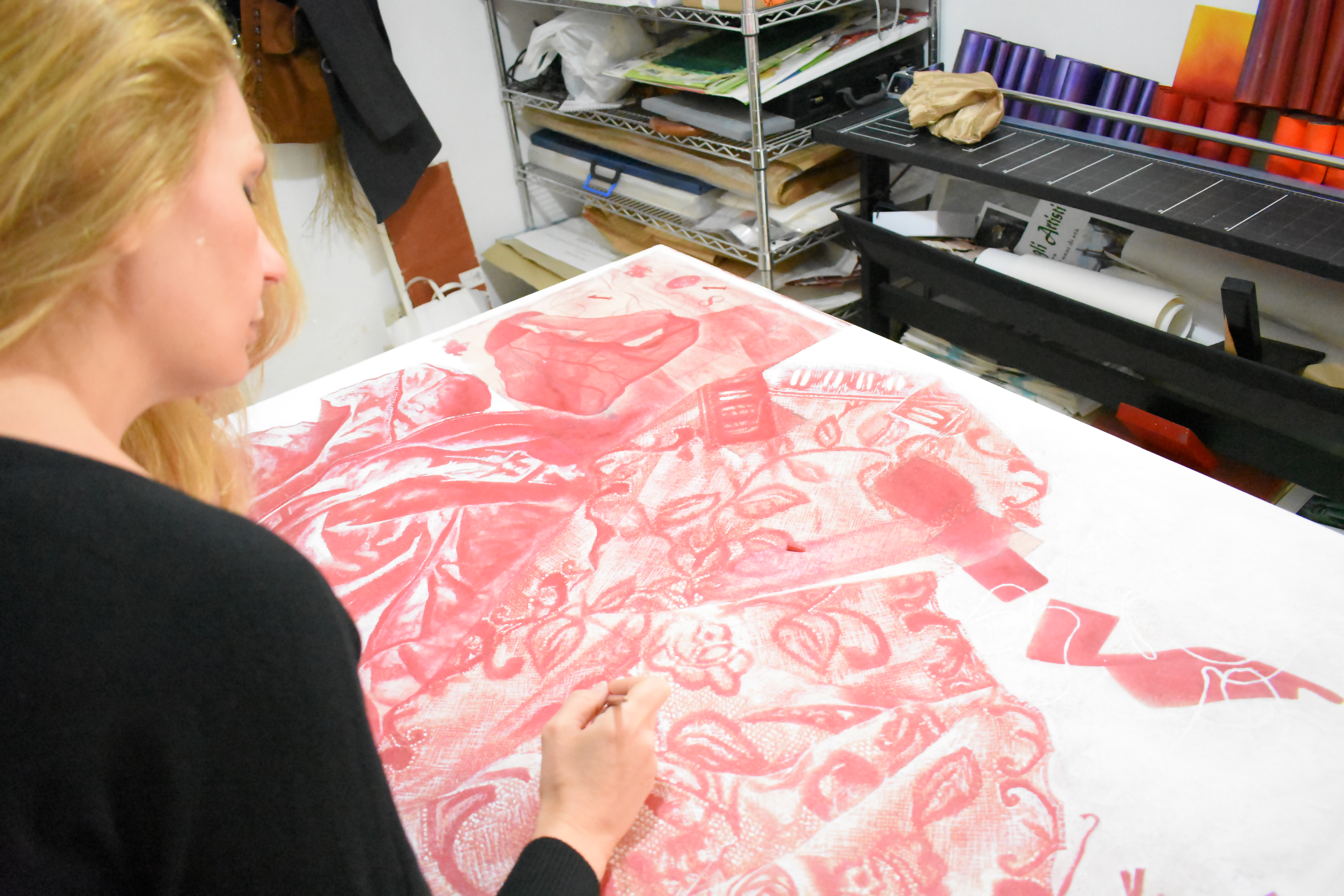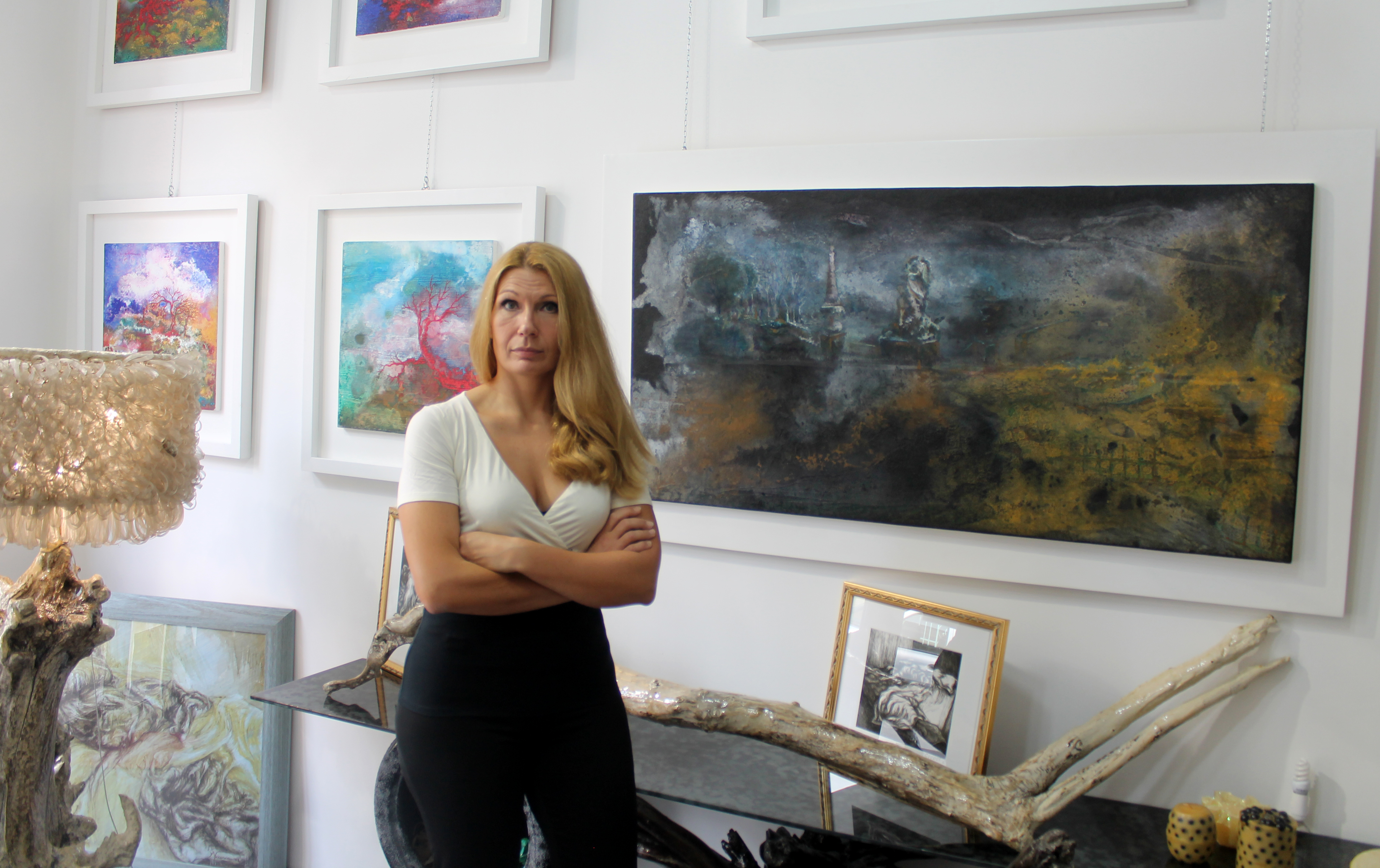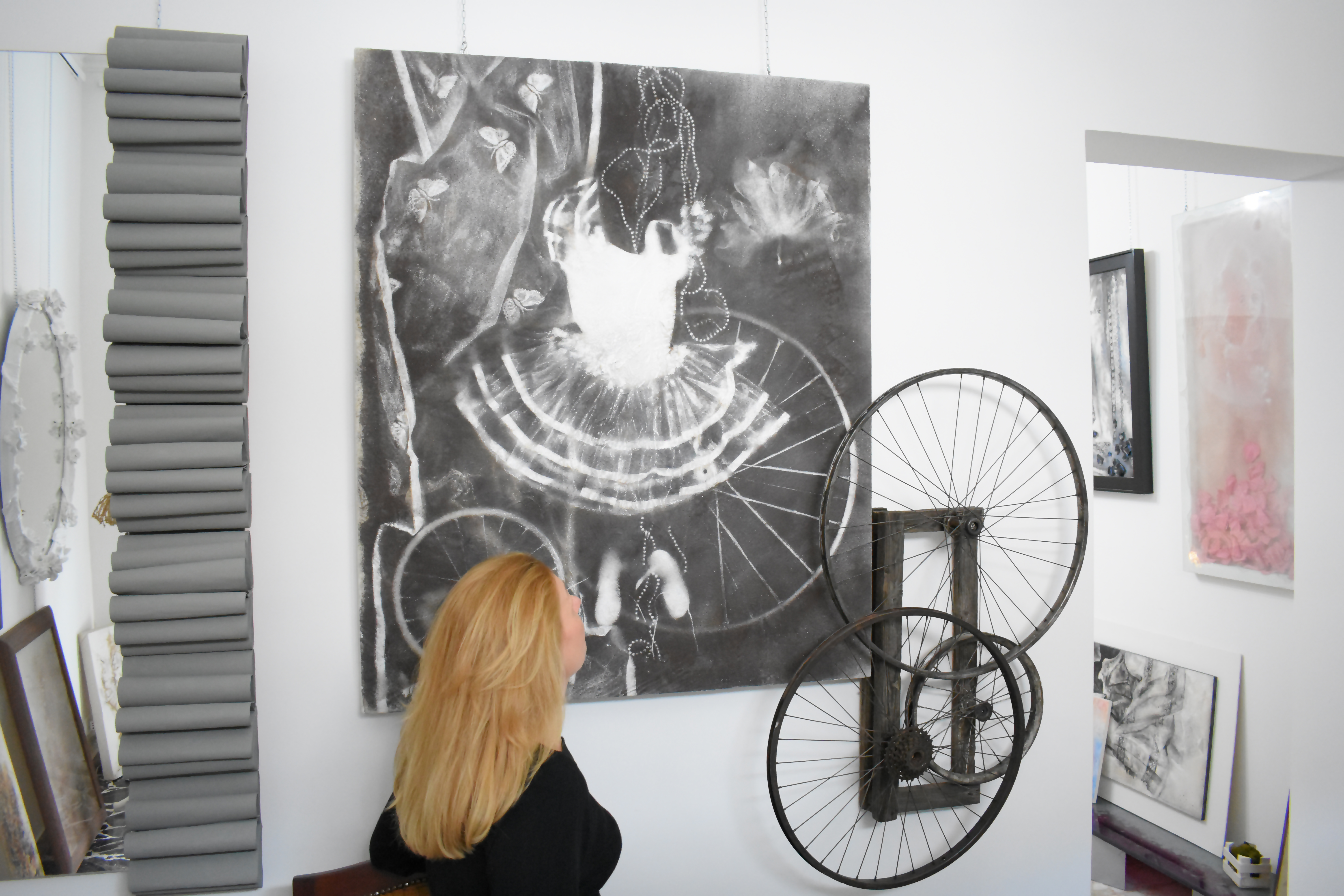Milena Nicosia is an acclaimed contemporary painter, draftsman, and printmaker from Italy. She uses pigments, pastel and engravings to create both monochromatic and color-oriented works. We sat down with Milena to talk about her day-to-day schedule in quarantined Italy.
What’s the first thing you do when you wake up in the morning?
Art has always been a part of my life. 90% of the time, it is my first waking thought and my last before falling asleep. My days vary depending on the project I’m working on. With my alarm clock usually ringing at 7am, my hearty breakfast is followed by a check-in with what has happened to my work-in-progress. I do this because almost all of my techniques are alchemist operations with a high dose of risk and unpredictability.
For example, when I use salts and acids on iron to create a long, slow corrosion; or when I imbue my works with pigment powder, water and fixative; or when I place the various fluid colors directly on the surface of the work; they mix and combine for days and nights. This is why my curiosity is at its highest in the morning. After taking a look at the changes, I decide whether it is best to continue working or abandon the piece in order to think about the next step.
What inspires you to create every day?
Many people ask me how I never stop and where I find the resources to be creative every day. Unfortunately, there will never be enough time to bring to life everything that I have in my mind and heart. I am inspired when I become enlightened about a certain project that sometimes has remained on standby in my mind for years. Once I start working on it again, I use a process consisting of experimentation in which I find the solution of various problems. This can be for a purpose that goes far beyond the work itself.
For example, in 2005 I wanted to tell the story of a woman’s body and soul through the clothes that covered her body, still reminiscent of the shape of her figure even after she was long gone. I needed a documentary technique that was real, yet unrealistic. So I looked to Man Ray’s photographic experiments, only mine concerned materials, with the marks of light or shadow reminding of an event. I was also intrigued by the clothes abandoned on a surface covered in dust that suggested a fluttering apparition – a presence reminiscent of an absence.
I did achieve my purpose, however, the endless story I wanted to tell with this project continues to this very day and consists of about 250 different works. Some of the series included are: ‘Spoglie’ , ‘Matrici’, ‘Anima di terra’ , ‘Giochiamo’ , ‘Scatole’ and ‘Deframmentazione’ to name a few.
Another very important project of mine came about in 2018, “I Muri del Tempo” (the walls of time). Here I aimed to analyze the transcendental links between past and present through the traces that time left on various surfaces. For instance, the windows of an abandoned house, with their dirty windows and mottled edges from which dusty figures (Figure di Polvere) stare back and speak to us. Elsewhere, the rusty iron findings (“Sotto la Ruggine“) where I discovered an ancient world full of old joys, sincere laughter and positive thoughts.
How has your life influenced your artistic expressions?
The world that unfolds in materials corroded by time is the world that I yearn for. It reflects my thoughts, my prayers, my escape from reality. My art has always walked hand in hand with my vicissitudes: from the overwhelming passion of my twenties, when I used the color of fire for the tangles on my “Letti disfatti” (unmade beds); or better still, “Cenere” (the ashes) in the aftermath of my fiery thirties where heat and emotions were replaced by frost and the depersonalization of black and white.
In recent years, I have let myself be carried away by pure, liberating emotions. I am not afraid to face great existential themes that are intense and penetrating. That fiery bed now lies in the remains of the soft skeleton of a rusty mattress (Quello che resta 1), soaked in every possible human feeling, deserving of a tribute as a sacred relic.

What does it feel like to be an Italian artist in a locked-down Italy?
The lockdown for me and my beloved Italy was unexpected and dramatic. There was so much excitement in my life during the first months of 2020 thanks to my participation in various fairs and exhibitions. And even though I’m physically fine, I’m still in a lot of pain. Learning online about the tragedies of families who lost their loved ones because of Covid-19 filled my heart with fear. Thinking about the tragic economic consequences that Italians will have saddens me deeply. I have often cried while watching some of the videos on social networks, where people beg desperately for help.
Truth be told, a very large section of the Italian population has been living on a small daily salary for years. These people don’t have a penny to their name set aside for unforeseen events or tragedies like these, and they are already having problems. Since the year 2000, Italy has not been the same and we have not yet recovered from the economic crisis of 2008. I personally experienced it since I had made some significant investments in my work. It took me 12 years to get back on my feet.

Being a creative person in Italy is very difficult and even more so if you are a woman. Women in art usually meet twice the problems that others do. A woman is often the subject of incredible enmity. She is often considered a dreamer – even delusional – if her ambitions do not fall under the normal category of having a family and children. Even when the latter is not her desired choice, she is still labeled a failure.
Working under these conditions aggravates me, but strengthens my armor. Art has always saved me and I trust in it. Art provides an infinite number of solutions. Therefore, being an artist in a locked-down Italy means finding a way to dream and survive. Even in this case, I have not stopped even for a minute. In fact, I am working even more, obsessively so, chasing time. I have more material in the house for my creations than food, so I won’t be facing any huge problems during this time of forced seclusion.
Describe the core of your technique or style for our readers.
Working at different techniques for me is like breathing after a period of apnoea. There is no particular “way” of doing things, no routine in the method I use. In fact, the predominant trait in everything I create is experimentation, unpredictability and my attempts at taming it, along with the surprise and the challenge of the result. Each work is unique in its own right due to its development and creative history. The work is created through a compromise between me and the material which has an organic and chemical life of its own. This pleasant struggle is stimulating and thrilling.
When I use powder pigments, my studio is in chaos. Preparation takes a very long time. After all the pigment has settled, the fixing phase lasts for days. When I use liquid pigments, the painting process is quite irreproachable, creating corrosion and castings that I pursue, direct and model.

I enjoy dominating the work while also reveling in its unpredictable nature, undefined and mysterious, leaking from every stain or rivulet of color. I like to use what I call non-colors by appearance or nature, such as iron rust, vegetable molds. Alternatively, I use natural products with dyeing properties, namely coffee, wine, cocoa or charcoal. Even when I do use actual colors, I prefer pure, natural powder pigments so that I can experiment with priming substances or dusty pigments.
When people look at the rust in my paintings, they think the elements were already in the final condition. Instead, the amount of work behind each piece is very long. Before making it public to other people, there are many phases followed by various experiments. Through this, I began to realize how I could obtain certain variations of rust, as in brighter or duller shades, more or less dusty hues, or crusts according to the substances used. After these observations, I would be able to fix the entire whole and how to give it the final touch. The more my work appears spontaneous and random, the more meticulous the process behind the scenes.
What do you like to do to unwind after a day’s work?
My techniques are both mentally and physically demanding. Sometimes I get as dirty as a worker on a construction site or in a coal mine. I’d have pigment all over my nose, hair and hands. I look like a farmer after a hard day’s work, so at the end of the day I immerse myself in a very long, hot bath. And then I like to talk to the people I love. However, relaxation for me is best done with reading and studying, discoveries and surveys. I have a passion for design and eco-sustainable innovations in architecture, as well as craftsmanship in all its forms, textiles in particular. Images and imagination are something I can never get enough of.
Interpreted by Audrey Higgans









